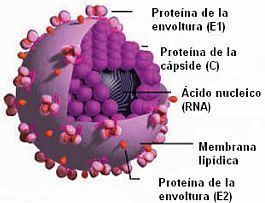Group Group IV ((+)ssRNA) Scientific name Hepacivirus Rank Genus | Higher classification Flaviviridae | |
 | ||
Similar Flaviviridae, Pestivirus, Positive‑sense single‑str, GB virus C, Hepadnaviridae | ||
Pnas characterization of nonprimate hepacivirus and construction of a functional molecular clone
Hepacivirus is a genus of viruses, in the family Flaviviridae. Humans serve as natural hosts. Diseases associated with this genus include: hepatitis; hepatocellular carcinoma.
Contents
- Pnas characterization of nonprimate hepacivirus and construction of a functional molecular clone
- Medical vocabulary what does hepacivirus mean
- Taxonomy
- Structure
- Life Cycle
- History
- Additional Information
- References

The type species is Hepatitis C virus.
Medical vocabulary what does hepacivirus mean
Taxonomy
Group: ssRNA(+)
Structure

Viruses in Hepacivirus are enveloped, with spherical geometries. The diameter is around 50 nm. Genomes are linear and non-segmented, around 10kb in length.
Life Cycle

Entry into the host cell is achieved by attachment of the viral envelope protein E to host receptors, which mediates clathrin-mediated endocytosis. Replication follows the positive stranded RNA virus replication model. Positive stranded rna virus transcription is the method of transcription. Translation takes place by viral initiation. Human serve as the natural host. Transmission routes are sexual, blood, and contact.
History

HCV, which is the causative agent of the hepatitis C in humans and the type species of the genus, was discovered in 1989.

GBV-B virus (also known as GB virus B) discovered in 1995 is capable of infecting New World monkeys, in particular tamarins. Like HCV it is transmitted by the blood-borne route and similar to HCV it is associated with the viral hepatitis. However GBV-B has never been identified in wild animals and its natural host is not known.
Additional Information
Additional hepaciviruses have been described from bats, rodents including bank voles, horses and dogs.
Cattle also appear to be a host for these viruses.
Rodent hepacivirus is found in the deer mouse (Peromyscus maniculatus).
A species related to this group has been isolated from the graceful catshark (Proscyllium habereri).
There are at least two subtypes of the Equine Hepacivirus.
